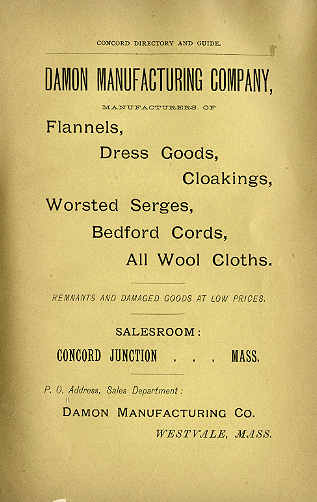

19. The End of the Damon Mill Era
Edward Damon ran the mill successfully through the 1880s. At that time the mill employed 175 people and had 40 tenements to house workers. But by the early 1890s, declining sales and overall changes in the textile industry began to affect business. Damon had converted the mill from flannel to dress goods production, a conversion that proved costly and from which the company was unable to recover. The decline came at a time when Edward Damon’s health was beginning to fail and his son Ralph was chiefly responsible for managing the business.
In 1893 Damon Mill was mortgaged to the Middlesex Institution for Savings, a move that the Damons were loathe to make. This advertisement in the 1892 Concord Directory and Guide illustrates the direction in which Ralph Damon had been attempting to take the company just one year earlier.
When the bank auctioned the property in 1898, the three-generation tenure of the Damon family, who had developed the mill that spawned a neighborhood, came to an end. But as the twentieth century approached, such an end was inevitable: a small factory in a Boston suburb was no longer a viable place to produce textiles.